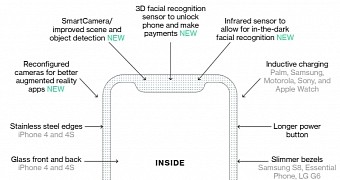The iPhone 8 will launch without a Home button, as Apple is betting big on facial recognition for authentication and payments, and this decision leads to a series of substantial changes in the way we use the device.
A report from Bloomberg reveals that the next iPhone will come with a taller screen, probably very similar to the Samsung Galaxy S8, with no bezels, but with a sensor bar at the top of the display that’s being referred to as “notch.” The notch will be the home of the facial recognition sensor, the FaceTime camera, and the earpiece, while the two sides will be all display and used to show specific information.
Notch and ears
Apple calls the two sides “ears” and the report reveals that the left one will show the time, while the right one will be used for cellular, Wi-Fi, and battery level. It’s not yet known where the other icons, like Bluetooth and alarm, will show. The status bar will change depending on app and will adapt to whatever users will do on the screen. The notch, however, will be always visible, but will blend into the rest of the display when locked or on a black background.
The removal of the Home button means Apple had to develop a new way to unlock the device, go to the home screen, and access the multitasking screen, and it looks like the company has turned to gestures in this regard.
The iPhone 8 will come with what’s being described as a thin software bar can be dragged up to the middle of the screen to unlock the phone (similar to Swipe to Unlock) or to open multitasking when running a specific app. The multitasking UI has been changed and uses standalone cards that users can simply check out individually by swiping left and right.
Dragging the software bar up to the top of the screen closes whatever app is running and goes back to the home screen, with the current implementation using an animation that sucks the app into its icon.
iPad-like dock
The iPhone 8 will come with a dock at the bottom of the screen very similar to the one on the iPad, and dragging the software bar reveals the icons that are placed on this dock.
Despite the bigger screen, the iPhone 8 will still show 24 icons on each page, plus the icons placed in the dock, which includes the commonly used apps, but which is likely to come with more customization features in this regard.
In terms of phone design, the iPhone 8 will be made of glass and feature a flat screen, and not curved, as it’s the case of Samsung phones. Additionally, the side frame will be made of stainless steel, with antenna lines on the corners, similar to the iPhone 4 and 4s.
The iPhone 8 will be unveiled on September 12, and sales are expected to begin on September 22. Pre-orders should kick off on September 15.

 14 DAY TRIAL //
14 DAY TRIAL //